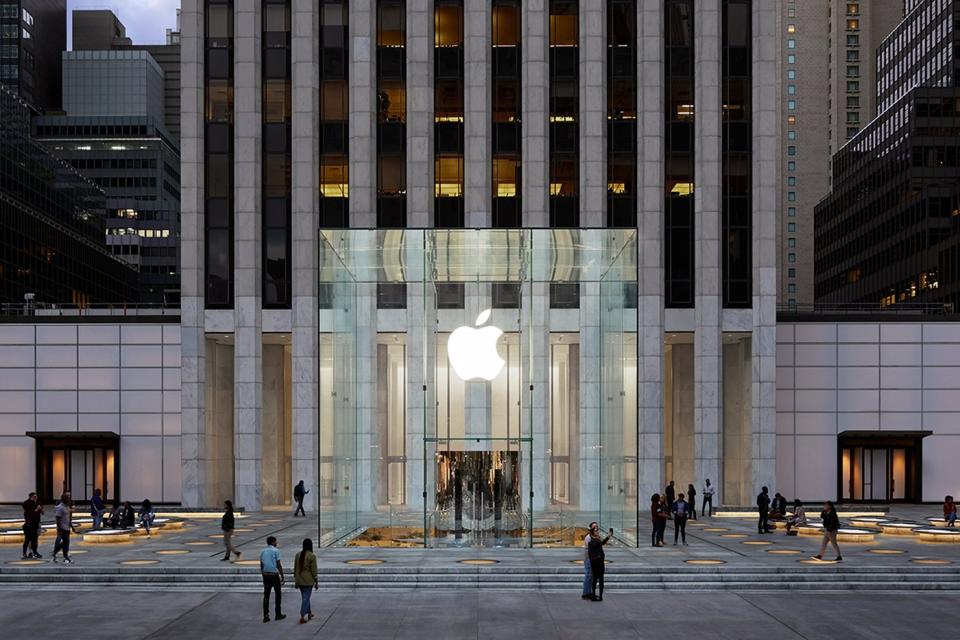Apple (NASDAQ: AAPL) recently became the world’s most valuable company again with a market cap of $3.57 billion. Its stock rallied more than 60% over the past three years, even as iPhone sales cooled off amid tougher macro and competitive headwinds.
From fiscal 2023 (ended last September) to fiscal 2026, analysts expect Apple’s revenue to grow at a compound annual growth rate (CAGR) of 5% as its earnings per share (EPS) rises at a CAGR of 10%. That growth will likely be driven by a cyclical recovery in iPhone sales, an expansion into higher-growth markets like India, and the evolution of Apple’s subscription ecosystem that hosts over a billion subscribers. Apple will also likely repurchase tens of billions of dollars in shares every year to boost its EPS.

Those growth rates make Apple a stable long-term investment, but they’re a bit weak for a stock that trades at 35 times forward earnings and 9 times this year’s sales. Therefore, Apple’s valuations might have been inflated by the recent hype regarding its generative AI plans for its first-party apps. Assuming Apple meets Wall Street’s estimates and still trades at the same price-to-sales ratio by fiscal 2026, its market cap could grow about 12% to $4.01 billion by the final year.
That market cap would still make Apple one of the world’s most valuable companies, but I believe three of its trillion-dollar peers — Nvidia (NASDAQ: NVDA), Microsoft (NASDAQ: MSFT), and Alphabet (NASDAQ: GOOG) (NASDAQ: GOOGL) — could eclipse its valuation over the next three years.
The key differences between these tech titans
Apple, Nvidia, Microsoft, and Alphabet operate different business models. Apple generates more than half of its revenue from the iPhone, but it relies on its services business to drive most of its growth. Nvidia generates most of its revenue by selling high-end data centers for processing AI tasks.
Microsoft generates over half of its revenue from its cloud businesses, which include its Azure cloud infrastructure platform, Office 365 productivity services, and Dynamics customer relationship management (CRM) services. Alphabet generates most of its revenue from Google’s advertising business, which includes its search and display ads, its advertising network, and YouTube. However, its smaller Google Cloud business is growing at a much faster clip than its core advertising business.
All four companies have been expanding their generative AI ecosystems. Apple recently integrated OpenAI’s ChatGPT into its own apps and announced new generative AI features for creating images and writing text. Microsoft, which is OpenAI’s top investor, integrates the start-up’s generative AI tools into its own cloud-based services.
Alphabet has been upgrading its Gemini generative AI platform to keep up with OpenAI, and it’s been rolling out those tools across its entire ecosystem. Nvidia profits from that secular trend by selling the best “picks and shovels” for the AI gold rush.
All three tech giants are growing faster than Apple
But out of these four companies, only Apple generates most of its sales from a slower-growth and cyclical consumer electronics business. Nvidia is a high-growth chipmaker, Microsoft is a cloud and AI play, and Alphabet is a digital advertising company. That’s why analysts expect all three companies to grow faster than Apple over the next three years.
Company
Estimated Revenue CAGR (Next 3 Fiscal Years)
Estimated EPS CAGR (Next 3 Fiscal Years)
Current Market Capitalization
Price-to-Sales Ratio (Forward)
Apple
5%
10%
$3.57 billion
9
Nvidia
46%
53%
$3.26 billion
28
Microsoft
15%
17%
$3.47 billion
14
Alphabet
11%
20%
$2.37 billion
7
Data source: MarketScreener.
Assuming they match those estimates and their price-to-sales ratios hold steady, Nvidia could be worth $5.3 trillion by fiscal 2027 (which ends in January 2027), Microsoft would be worth $4.5 trillion by fiscal 2026 (which ends in June 2026), and Alphabet’s market cap could reach $3 trillion. But with the same price-to-sales ratio as Microsoft, Alphabet’s market cap could nearly reach $6 trillion. Therefore, all three tech giants have a shot at eclipsing Apple’s market cap over the next three years.
But look beyond the market caps
It’s interesting to track the market caps of the world’s largest companies, but it’s a superficial approach that glosses over their core strengths and weaknesses.
All four of these “Magnificent Seven” stocks will likely keep growing. Apple is a rock-solid investment in the mobile computing market, Microsoft and Google are evolving into cloud and AI companies, and Nvidia is still arguably the best pure play on the AI accelerator chip market. So instead of wondering which tech giant will be the most valuable in three years, investors should simply focus on their ability to expand their ecosystems, widen their moats, and generate consistent growth.
Should you invest $1,000 in Apple right now?
Before you buy stock in Apple, consider this:
The Motley Fool Stock Advisor analyst team just identified what they believe are the 10 best stocks for investors to buy now… and Apple wasn’t one of them. The 10 stocks that made the cut could produce monster returns in the coming years.
Consider when Nvidia made this list on April 15, 2005… if you invested $1,000 at the time of our recommendation, you’d have $791,929!*
Stock Advisor provides investors with an easy-to-follow blueprint for success, including guidance on building a portfolio, regular updates from analysts, and two new stock picks each month. The Stock Advisor service has more than quadrupled the return of S&P 500 since 2002*.
*Stock Advisor returns as of July 8, 2024
Suzanne Frey, an executive at Alphabet, is a member of The Motley Fool’s board of directors. Leo Sun has positions in Apple. The Motley Fool has positions in and recommends Alphabet, Apple, Microsoft, and Nvidia. The Motley Fool recommends the following options: long January 2026 $395 calls on Microsoft and short January 2026 $405 calls on Microsoft. The Motley Fool has a disclosure policy.
Prediction: 3 Stocks That Will Be Worth More Than Apple 3 Years From Now was originally published by The Motley Fool
Source: finance.yahoo.com
